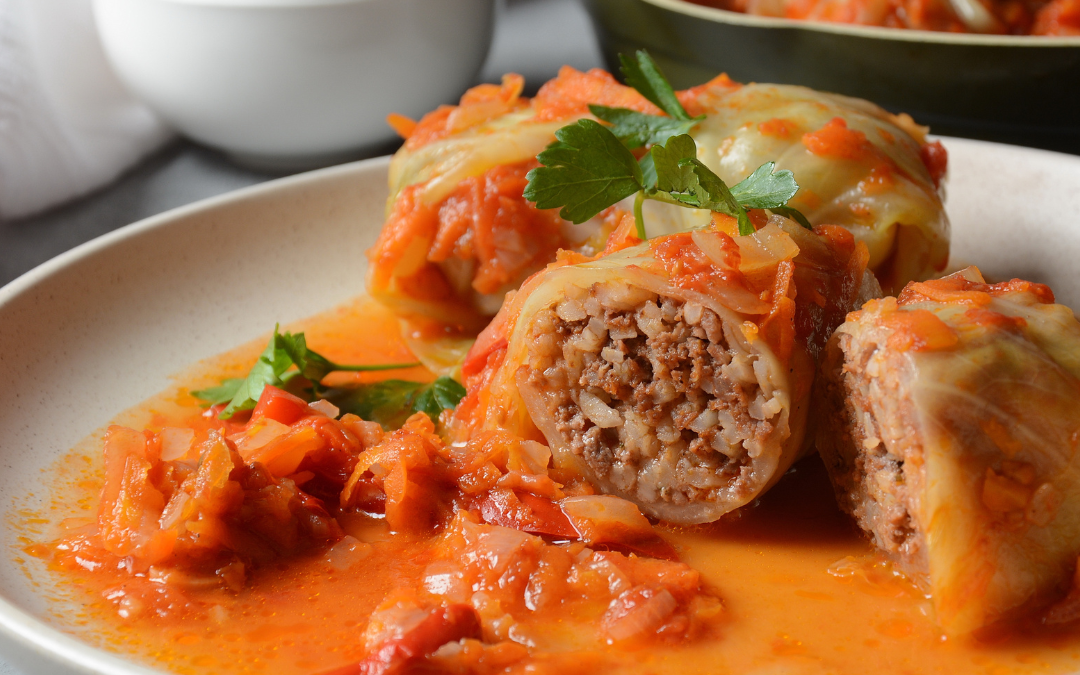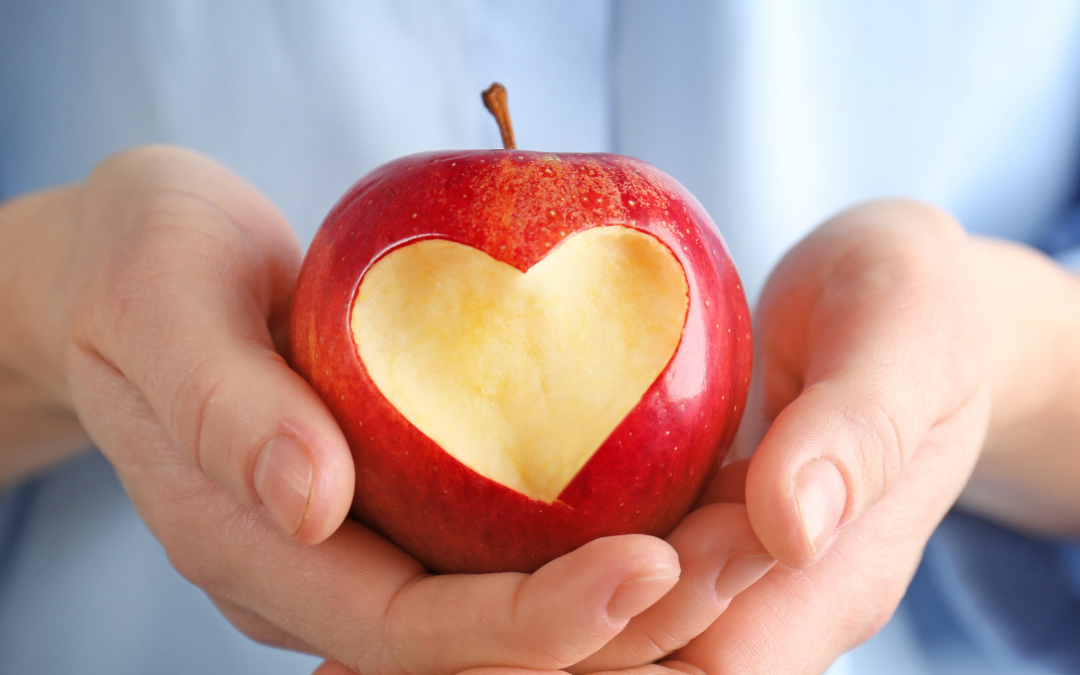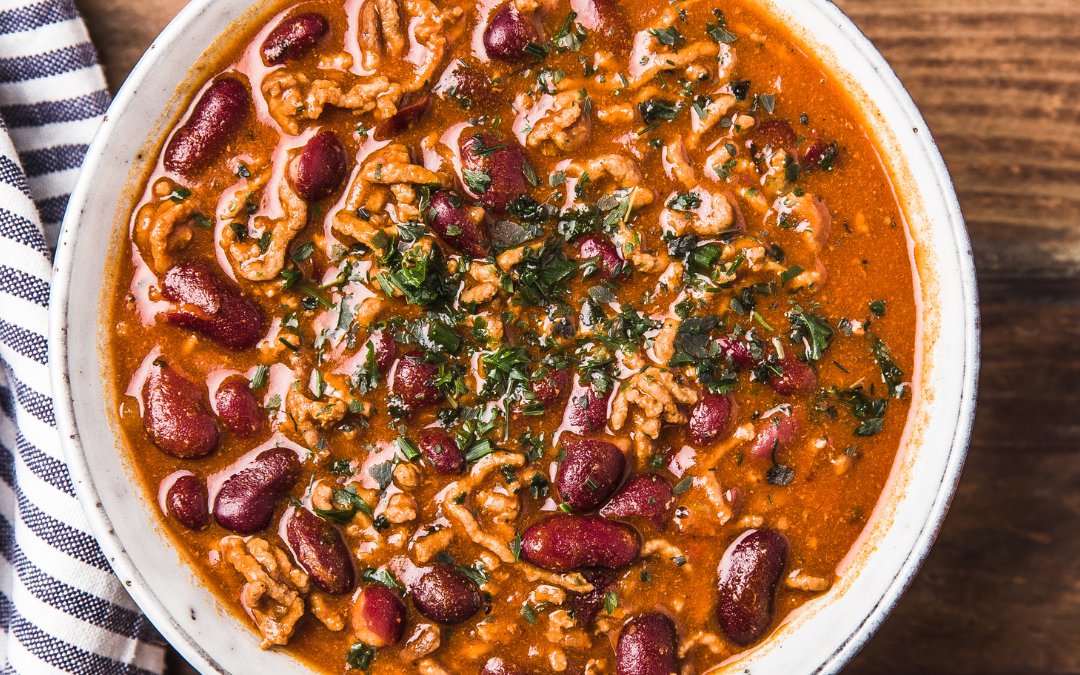
by Guest | Apr 30, 2025 | Eat Well, Featured, Lunch & Snack Recipes, Recipes, Uncategorized
Level up your lunch with these Salmon-Stuffed Avocados—creamy, delicious, and packed with gut-friendly goodness! The Greek yogurt provides beneficial probiotics, while avocado and celery deliver fiber to support digestive wellness. It’s a tasty, feel-good meal that’s as kind to your gut as it is flavorful.
Ingredients
- ½ cup nonfat plain Greek yogurt
- ½ cup diced celery
- 2 tablespoons chopped fresh parsley
- 1 tablespoon lime juice
- 2 teaspoons mayonnaise
- 1 teaspoon Dijon mustard
- ⅛ teaspoon salt
- ⅛ teaspoon ground pepper
- 2 (5 ounce) cans salmon, drained, flaked, skin and bones removed
- 2 avocados
- Chopped chives for garnish
Directions
- Combine 1/2 cup yogurt, 1/2 cup celery, 2 tablespoons parsley, 1 tablespoon lime juice, 2 teaspoons mayonnaise, 1 teaspoon mustard, 1/8 teaspoon salt and 1/8 teaspoon pepper in a medium bowl; mix well. Add 5 ounces salmon and mix well.
- Halve 2 avocados lengthwise and remove pits. Scoop about 1 tablespoon of flesh from each avocado half into a small bowl. Mash the scooped-out avocado flesh with a fork and stir into the salmon mixture.
- Fill each avocado half with about 1/4 cup of the salmon mixture, mounding it on top of the avocado halves. Garnish with chives, if desired
Resource: https://www.eatingwell.com/recipe/270549/salmon-stuffed-avocados/

by Guest | Mar 14, 2025 | Eat Well, Featured, Recipes
This twist on a classic favorite is versatile and can be adapted based on the ingredients you have available.
Ingredients:
1 large head of cabbage
1 pound lean ground beef, pork, poultry (uncooked)
1 can (15 ounces) tomato sauce, divided (see Notes)
1 cup cooked brown rice (see Notes)
1 cup chopped onion
½ cup chopped bell pepper
¾ teaspoon garlic powder
½ teaspoon basil
½ teaspoon oregano
¼ to ½ teaspoon paprika or cayenne pepper
¼ teaspoon salt
¼ teaspoon black pepper
¼ cup chopped parsley, dill or cilantro (optional)
Directions:
- Wash hands with soap and water.
- Rinse fresh vegetables under running water before preparing.
- Preheat oven to 350 degrees F.
- Use these steps to remove 12 cabbage leaves from the head:
- Trim off the bottom of the cabbage and carefully remove the core with a sharp knife.
- Place cabbage, core-side down, in a deep microwave-safe dish along with one inch of water.
- Microwave on HIGH for 10 minutes.
- Carefully remove cabbage from the microwave.
- Let cool until safe to handle.
- Pull leaves from the outside of the cabbage and set aside. Return to the microwave for 2 to 3 minutes, if needed, to remove enough leaves.
- Spread ½ cup tomato sauce on the bottom of a 9×12-inch baking dish.
- In a large bowl, mix together the beef, rice, ½ cup tomato sauce, onion, bell pepper, garlic powder, basil, oregano, paprika, salt and black pepper.
- Put about ¼ cup meat mixture in the middle of a cabbage leaf near the core end. Roll the bottom edge of the cabbage over the meat, then fold each side into the middle and continue rolling tightly. Place the roll seam side down in the baking dish. Repeat with remaining leaves and filling.
- Pour the remaining tomato sauce over the rolls.
- Cover the dish tightly with a lid or foil and bake for 1 hour. The cabbage leaves should be tender and the inside temperature at least 160 degrees F on a food thermometer.
- Spoon a little sauce from the bottom of the dish over a serving cabbage rolls and top with chopped parsley, if desired.
- Refrigerate leftovers within 2 hours.
Notes:
- Use any cooked beans or grains in the filling, such as white beans and barley.
- For a flavorful tomato sauce, add 1 teaspoon sugar and ¼ teaspoon each cumin and coriander before dividing. You can also make a sauce with chopped vegetables such as carrots and zucchini.
- Use the remaining cabbage for a salad, soup or stir-fry.
- No microwave? You can soften the cabbage leaves other ways:
- Place the trimmed and cored cabbage in a deep pot. Cover with boiling water and simmer for about 4 minutes. Remove leaves with tongs as they soften.
- Place the trimmed and cored cabbage in the freezer. Defrost cabbage in the refrigerator. The leaves will peel off easily.
From FoodHero.org

by Guest | Feb 19, 2025 | Eat Well, Featured, Move Well, Recipes, Uncategorized
Written by Eva Foley, Oregon Dairy Council Intern
Did you know that your heart is the most important muscle for your overall health and well-being? This special organ delivers oxygen to your entire body and deserves the best treatment from you, its owner, to keep it working for a long, healthy life. Giving your heart some tender loving care starts with something you do every day: eat! This means that with each meal and snack, you can strengthen your health by making heart-smart decisions about the foods you eat. February is National Heart Health Month, so let’s dive into some savvy food choices that will make your heart happy!
- Fruits and vegetables: Plan to eat 2-3 servings of each fruit and vegetables per day. A good way to think about it is adding one fruit and one vegetable to each meal or snack. Picking fruits and vegetables that are in season usually means better flavor and texture and paying less at the store. Frozen or canned fruits (without added sugar or heavy syrup) and vegetables (without added salt or sauces) are just as nutritious as the fresh kind and will last longer.
- Dairy: Studies have shown that 2 servings per day of fat-free or low-fat dairy have a protective effect on the heart. Dairy is also an affordable addition to most diets and can be included in many recipes, both sweet and savory.
Lactose intolerant? Check this out: https:/www.niddk.nih.gov/health-information/digestive-diseases/lactose-intolerance/eating-diet-nutrition
- Fiber: The goal for fiber in a heart-healthy diet is 25-30 grams per day from foods. Both soluble (think oats and beans) and insoluble (think whole grains, fruits, and vegetables) are important to include. Increase fiber intake slowly over time to allow your body to adjust to the right amounts.
- Healthy fats: Including the right kinds of fats in your diet helps you feel satisfied after a meal and nourishes a healthy heart. Foods like avocados, nuts, and seeds supply healthy unsaturated fats, while limiting saturated fats (such as butter, coconut, and palm oils) is just as important.
- Lean proteins: The right kind of protein supports heart health by building stronger muscles and helping to control hunger between meals. Boneless, skinless chicken breasts, fish and seafood, and tofu are all great options. Remember, many dairy foods, vegetables, legumes, and nuts contain protein, too!
- Limit salt and added sugar: Limit sodium intake to 2300 milligrams or less per day and aim for no more than 25 grams of added sugar per day for women (36 grams per day for men). You can find how much sodium and added sugar a packaged food has per serving on the nutrition label. It’s important to remember that the sugars to limit are those that are added to a food (such as table sugar or high fructose corn syrup); sugars that are naturally part of fruits and dairy products should not be counted towards daily added sugar intake.
Helpful links:
Serving sizes/portions: https://www.myplate.gov/
Are you ready to get started with a heart healthy recipe? This comforting breakfast for all ages supplies fruit, dairy, and both soluble and insoluble fiber for a healthy start to your day. It’s easy to make ahead of time and portion out for a quick, on-the-go breakfast treat. Top with a serving of plain Greek-style yogurt to boost your dairy and protein intake.
Apple Spice Baked Oatmeal
Prep time: 10 minutes; makes 9 servings
Ingredients:
- 1 egg, beaten
- ½ cup applesauce
- 1 ½ cups nonfat or 1% milk
- 1 teaspoon vanilla
- 2 Tablespoons vegetable oil
- 1 apple, cored and chopped (about 1 ½ cups)
- 2 cups old fashioned rolled oats
- 1 teaspoon baking powder
- ¼ teaspoon salt
- 1 teaspoon cinnamon
- Topping:
- 2 Tablespoons packed brown sugar
- 2 Tablespoons chopped nuts (optional)
Directions:
- Wash hands with soap and water.
- Rinse or scrub fresh fruits under running water before preparing.
- Preheat oven to 375 degrees F. Lightly oil an 8×8-inch baking dish.
- Combine the egg, applesauce, milk, vanilla and oil in a bowl. Mix in the apple.
- In a separate bowl, mix the rolled oats, baking powder, salt and cinnamon. Add to the liquid ingredients and mix well.
- Pour mixture into baking dish and bake for 25 minutes.
- Remove from oven and sprinkle with brown sugar and (optional) nuts.
- Return to oven and broil for 3 to 4 minutes until top is browned and the sugar bubbles.
- Serve warm. Refrigerate leftovers within 2 hours.
Notes:
- Substitute other fruit for the apple. Try bananas, pears, blueberries or a mixture.
- Serve warm topped with vanilla yogurt.
Photo & Recipe Source: https://foodhero.org/recipes/apple-spice-baked-oatmeal

by Guest | Dec 2, 2024 | Eat Well, Featured, Recipes
A rich and flavorful chili made with lean ground turkey, hearty beans, and a blend of aromatic spices!
Ingredients
1 teaspoon vegetable oil
1 pound lean ground turkey (15% fat)
⅔ cup chopped onion (about ½ medium onion)
½ cup chopped green pepper (about 1 small pepper)
2 cloves garlic, minced or ½ teaspoon garlic powder
1 can (15 ounces) kidney beans, drained and rinsed
1 can (15 ounces ) great northern beans, drained and rinsed
1 can (16 ounces) pumpkin
1 can (15 ounces) crushed tomatoes
1 can (15 ounces) low-sodium broth
½ cup water
2 Tablespoons packed brown sugar (optional)
1 package taco seasoning mix (1.25 ounces)
To make gluten-free, choose gluten-free options for broth and taco seasoning.
Directions
- Wash hands with soap and water.
- Rinse fresh vegetables under running water before preparing.
- In a large saucepan, heat oil on medium heat.
- Add ground turkey, onion, green pepper and garlic.
- Cook and stir, breaking meat apart until it is brown and vegetables are tender.
- Stir in the beans, pumpkin, tomatoes, broth, water, brown sugar and taco seasoning.
- Bring to a boil. Reduce heat, then cover and simmer for 1 hour.
- Refrigerate leftovers within 2 hours.
Notes
- Broth can be made at home, purchased in a can or box, or made using bouillon. For each cup of broth use 1 cup very hot water and 1 teaspoon or 1 cube of bouillon.
- Use leftover turkey cut in bite-size pieces instead of ground turkey. Sauté the vegetables, then add the turkey with the other ingredients.
- No Taco Seasoning? Mix together 1 Tablespoon chili powder and 1 teaspoon each cumin and oregano. Add some red pepper flakes if you like it spicier.
- This recipe can be made in a 5-quart or larger slow cooker for extra convenience. Put cooked ground turkey mixture and all other ingredients into the cooker, cover and cook on LOW for 7 to 9 hours or on HIGH for 4 to 5 hours.
Recipe from foodhero.org

by Guest | Oct 28, 2024 | Being Well, Featured, Uncategorized
…to taking action for breast cancer prevention and healing.
October is breast cancer awareness month. It’s also my birthday month, and I’m happy to say, I’ve come a long way in my healing as I now feel honored to share my birthday month with this awareness as many of us would like to not have to touch it with a 10 foot pole. You see, I’ve learned much about breast cancer from lived experience, both my own diagnosis and one of my sisters. My sister’s story ended with her dying from metastatic breast cancer only 2 years from her original diagnosis. I’m currently 2.5 years out and doing great as I plan to continue to do.
Neither of us were paying enough attention to our risk factors and we had several. There were many factors involved including earlier cancers and radiation treatments, environmental toxin exposures (we all live in a chemical soup world, reducing our exposures and supporting our body’s pathways of elimination are key) emotional and physical overwhelm/high stress, over-nurturing others and under-nurturing the self. Sound familiar anyone? 1 in 8 are the current statistical numbers of breast cancer occurrence among women. Also, did you know? 1 in 100 men are affected. Each story is unique and there are certain things that put each of us in different risk categories.
Knowing our risk factors, how many we have and what we can do to lower our risk factors with lifestyle modification are all within our control. I knew I was in a higher risk category from having had radiation therapy in my early 20’s. I knew I functioned at a high stress level, saw signs of estrogen dominance, was persistently overweight for many years, chronically inflamed and worked nights often as a birth doula plus a few other factors. Yet I just hoped eating organically and not exposing myself to more radiation would keep me healthy. It wasn’t enough. Receiving the diagnosis of invasive ductal carcinoma right after my sister’s passing was a doozy of a hit too, but through my lifestyle adaptions it has ultimately brought me back to my earlier life goal of longevity (living to 100 or beyond!) and living that life in vibrant wellness. Good health has always been a passion of mine, but it’s funny how we can let stress and certain situations lead us to believe we should accept less for ourselves. Ultimately cancer has taught me how to live well again. Thank goodness! However, it was not easy to go through to get myself back on track. I don’t actually recommend it 😉 It is therefore, my pleasure and task to share with others what they can do to ideally avoid diagnosis by steering away from known risk factors and incorporating lifestyle habits that decrease risk factors. I love sharing preventive habits and skills in general for us all (including prevention of other diseases too I’d like to add).
Know your risk factors. How many of these align with you?
Risk factors from CDC
- Being a woman
- Age: most diagnosed after 50
- Having BRCA1&2 genes (genetics can be dimmed or brightened with lifestyle)
- Reproductive history – beginning menstruation before age 12 and menopause after 50 – also – First baby after 30, no breast feeding, no full term pregnancy
- Having dense breast tissue/connective tissue (hard to read in mammograms and needs better lymph movement and movement in general) Ultrasound and thermography** are better at reading dense breast tissue **note that thermography isn’t currently utilized by conventional medicine.
- Having a personal history of breast cancer
- Other breast diseases such as atypical ductal hyperplasia, lobular carcinoma in situ
- Family history of breast or ovarian cancer (with or without BRCA gene) first degree relative; mom, sister, daughter – mother or father side
- Previous treatment with radiation (such as Hodgkins lymphoma also a sign the lymph system needs support)
- Exposure to DES drug – diethylstilbestrol – 1940-1971 – miscarriage prevention (mom and baby at higher risk)
- Not physically active
- Overweight or obesity after menopause
- HRT – hormone replacement therapy and slight increased risk seen from birth control pills.
- Drinking alcohol – risk increases with the more a woman drinks
- Smoking
- Night shift work
I would also add: environmental and food chemical additives that can overload our lymph and endocrine system as well as harm our gut microbiome.
Now to the empowering stuff!
What we can do: Taking action is key!
Eat more whole food plants! Eat more colors, eat seasonally, locally and clean/organic whenever possible. Check out the EWG’s list of clean 15 and dirty dozen to know what produce is ok to buy conventional/clean15 and which are ideal to buy organic/dirty dozen) Visit a local farm and enjoy their produce. They need our business through the cooler seasons too. Add one more vegetable to every meal and one new color a week. Ask about the farm’s growing habits. Find farms that don’t use chemicals. Many practice organic methods but don’t carry the certification yet and they’re happy to answer your inquiries.
Exercise! Move your body in ways that make you happy and feel good. Get moving every day. And this doesn’t mean stressed out running around, no, that’s counter productive. This means, enjoy a walk, hike or bike ride. Prioritize the time to commit to regular movement. You are so worth it! Walk one day, take a movement class another day such as Yoga or Joy Lymph Flow (a class I lead in Rockaway Beach and Nehalem) Tai Chi, Qigong or whatever you fancy, but it should bring ease to your body and time for repose. Turn on the music and dance! A fabulous way to heal many layers and promotes connection and health within the family if you live with others.
Quit smoking and don’t drink alcohol or limit your intake. Mocktails made with herbs are power packed with more phytonutrients that help us stay well and are an actual treat vs. a known risk factor.
Switch to natural household and personal care products. Don’t use anything with “fragrance” listed as an ingredient or chemical names you can’t pronounce or artificial colors. There are so many products out there, it can be overwhelming. Environmental Working Group also has a Skin Deep database listing products that are free from chemicals. It’s not one product that becomes the problem, it’s the many products together, it becomes a toxic load the body can’t handle. Switching to natural cleaners and personal care items actually uplifts our health instead.
Discuss your risk factors with your ND or MD and meet with a health coach like myself for support in making changes to your lifestyle at a pace that works for you to live a life that’s shown to be more preventive in lowering your risk factors and ideally avoiding this disease. I also teach breast massage for self-care and home screening. 3 This article is dedicated to those we’ve loved and let go of too early due to this disease and to those facing it now and in the future. May we all be free, live in flow, know ease and enjoy self care first so we may indeed be well and remain here for others.
Written by Elizabeth Golden Seaver, Health and Wellness Coach, Nehalem, OR and Tillamook County Wellness Coalition Member.
You can reach out to her at: goldenkeywellness.abmp.com, wingforwisdom@gmail.com
Other wellness questions? Email us at info@tillamookcountywellness.org. For more local health and wellness information, visit www.tillamookcountywellness.org or follow Tillamook County Wellness on Facebook and Instagram.





